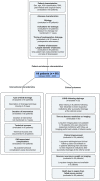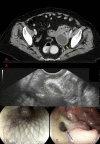Safety and clinical efficacy of EUS-guided pelvic abscess drainage
- PMID: 37693116
- PMCID: PMC10437202
- DOI: 10.1097/eus.0000000000000020
Safety and clinical efficacy of EUS-guided pelvic abscess drainage
Abstract
Background and objectives: EUS is a potential alternative for the drainage of abscesses. The aim of this study was to determine if EUS-guided pelvic abscess drainage is technically feasible, safe, and a valid option for abscess resolution.
Methods: We conducted a retrospective review from 2002 to 2020 at a single quaternary institution. EUS-guided pelvic abscess drainage via the transrectal route was performed in all patients with or without drain/stent placement. Technical and clinical success of EUS-guided pelvic abscess drainage was analyzed. Descriptive analyses and Fisher exact test were performed.
Results: Sixty consecutive patients were included in the study (53.5% male; mean age, 53.8 ± 17.9 years). Pelvic abscesses occurred mainly postoperatively (33 cases; 60.0%) and from complicated diverticulitis (14 cases; 23.3%). Mean diameter was 6.5 ± 2.4 cm (80% unilocular). Drainage was performed with EUS-guided stent placement (double-pigtail plastic or lumen-apposing metal) in 74.5% of cases and with aspiration alone for the remainder. Technical success occurred in 58 cases (97%). Of those with long-term follow-up after EUS-guided pelvic abscess drainage (n = 55; 91.7%), complete abscess resolution occurred in 72.7% of all cases. Recurrence occurred in 8 cases (14.5%) and persisted in 7 patients (12.5%), 7 of which were successfully retreated with EUS-guided pelvic abscess drainage. Accounting for these successful reinterventions, the overall rate of abscess resolution was 85.5%. Abscess resolution rate improved with drain placement (83%). Accounting for 7 repeat EUS-guided pelvic abscess drainages, overall abscess resolution improved. Two deaths occurred (3.4%) because of sepsis from failed source control in patients who had previously failed medical, radiological, and surgical treatment.
Conclusions: EUS-guided pelvic abscess drainage is technically feasible, safe, and an effective alternative to radiological or open surgical drainage. It also offers favorable clinical outcomes in different clinical situations.
Keywords: EUS; Lumen-apposing metal stent; Pelvic abscess; Transrectal drainage.
Copyright © 2023 The Author(s). Published by Wolters Kluwer Health, Inc on behalf of Scholar Media Publishing.
Conflict of interest statement
The authors have nothing to disclose.
Figures


References
-
- Robert B, Yzet T, Regimbeau JM. Radiologic drainage of post-operative collections and abscesses. J Visc Surg 2013;150(3):S11–S18. - PubMed
-
- van Sonnenberg E, Wittich GR, Goodacre BW, Casola G, D'Agostino HB. Percutaneous abscess drainage: update. World J Surg 2001;25(3):362–369. - PubMed
-
- Varadarajulu S, Drelichman ER. Effectiveness of EUS in drainage of pelvic abscesses in 25 consecutive patients (with video). Gastrointest Endosc 2009;70(6):1121–1127. - PubMed
-
- Puri R Choudhary NS Kotecha H, et al. . Endoscopic ultrasound–guided pelvic and prostatic abscess drainage: experience in 30 patients. Indian J Gastroenterology 2014;33(5):410–413. - PubMed

